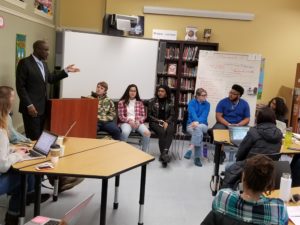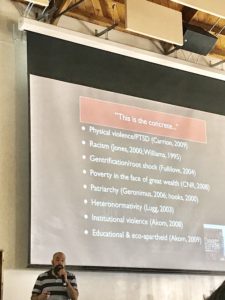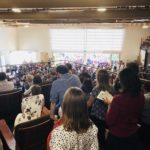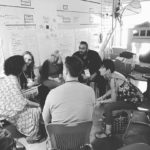At the end of March, I attended the Deeper Learning conference, which took place at High Tech High’s campus in San Diego. This was my first time at Deeper Learning, and I got a good sense of why this is an important gathering for progressive educators throughout the United States. In some ways, Deeper Learning is a new iteration of the Coalition of Essential Schools (CES) and that made me very happy. The Ten Common Principles were the foundation of CES and much of Deeper Learning has its roots there.
First of all, the tag line for the conference, from James Baldwin: “Not everything that is faced can be changed, but nothing can be changed until it is faced,” resonated with me. Facing issues and figuring out how to improve education for young people, especially the most vulnerable and disenfranchised amongst us, is why many people were there. It was wonderful to see “old” young friends from my “Building Democratic Schools” class that I have taught at HGSE for 17 years. Michael Lipset, Hannah Kehn, Anna Klafter, and Hannah Williams were all there with colleagues, providing support or workshops and cheering on others. And it was affirming to see many others from CES days.
I was proud to see Tommy Hayes and Paul Kemp from Charlestown High School’s Diploma Plus program giving a terrific workshop on how to use the Black Panther Party’s ten-point platform in math/science classes.
I learned how SchoolRetool.org is supporting principals and assistant principals to make small but meaningful changes in their schools.
I was fortunate to share a Deep Dive Den conversation with Jennifer Husbands from Schools that Can Chicago where we had the chance to touch upon the ways in which deeper learning does or does not speak to issues of equity and racial justice. We discussed the difficulties of supporting people to lead and teach in ways that are different from what they have experienced. As we sat on the beautiful High Tech High campus, we asked how can we ensure that ALL students are getting access to high-quality deeper learning?
The conference concluded brilliantly with educator, speaker, and writer Jeffrey Duncan-Andrade, who is even more inspiring in real life than on video. He reminded us that 1) racism is a toxic disease and that 2) hope is critical.
I think what makes a conference valuable is when it helps you let go of all the reasons you can’t do something. You stop thinking, “But my school isn’t in such a beautiful location with so much space,” or “at my school I can’t do this because… fill in the blanks.” A good conference allows for an a-ha moment when you return back to work.
Four days later I had one of those.
It occurred in my current HGSE “Building Democratic Schools” class. My students are all designing mission-driven schools that solve a specific need in their communities. These designers are thinking about schedules and ways to ensure deeper learning. Seventh and eighth grade students from Conservatory Lab Charter School joined my graduate students to talk about their experiences in schools. Some of the Conservatory Lab students have been at the school, and playing music, for nine years; others have only been there a short time. Hearing from middle school students reminded us all about what we must pay attention to in our schools.
The young students talked about how they disliked long blocks of classes. My graduate students were disturbed by this, since many of their designs call for long blocks. But here’s what students said:
“I need to move around. My body needs to move. And not just about the room. But I need to run and let off energy. In a long block—especially with lots of reading and writing, I can’t do that.”
Another added, “I have ADD and sitting and reading is really hard for me, but when I can move, I can concentrate better.”
Another question from my graduate students to the younger students was about how you know you are learning something. The answer: “I can just feel my brain clicking. Like when I understand the math problem; or I figure out how the robot will move or when the essay makes sense and I know I’ve understood the book.” And another student said, “But that’s not the feeling I have when I have learned music and I can play it well. Then, I am not thinking. The music is just coming out of me.” We nodded at that. This student was describing Csikszentmihalyi’s flow in his own terms.
Other Conservatory Lab students emphasized what we know: relationships matter. “I like small classes because then my teacher can get to know me. I can get help easily. I don’t feel stupid asking questions.” Later in a more one-on-one conversation, another revealed that it’s been very hard at his school since so many teachers have come and gone. “But the science teacher has been there three years and we all know that. And we love science. She cares about us.” Whatever the reasons that teachers leave a particular school or classroom, students notice and it matters to them.
Another Conservatory Lab student asked if my graduate students knew about “fluxus.” They didn’t. The young seventh grader looked curiously at the graduate students as if to say, “How can you not know about fluxus, it’s so cool?!” This young violin player explained that you could take your bow and hold it differently and make sounds differently on the strings. “It’s just really fun—you can almost turn your musical understanding upside down and play with making music.” Another chimed in, “It’s so cool that we get to study this kind of thing in school. None of our friends are as good at music or know so many different kinds of ways to play music.”
Conservatory Lab students described why they loved music. “I can be in a bad mood and I come into music class and I can literally take it out on my viola and make angry sounds or play really hard and then I feel better. I am working on sounding better than yesterday. That’s such a good feeling.”
While few of the younger students wanted to be professional musicians, all wanted to make sure that music and other forms of art stay in their lives. One reminded the class. “We are all musicians. We all play every day, but this year we also do visual art, and that’s so much fun. Now we can express ourselves in more than one way. We need to be able to do that.”
My graduate students wanted to know, “Why is music important to you?” It was a “deep” question. All hands shot up to answer. One Conservatory Lab student said it this way, “You know that music is everything and everywhere. How can we live without music?” He looked at the student who had just swiveled in her chair. “Music is when you turn in your chair, or when you take a sip from your straw as you drink. Music is also in the silence.” We were quiet and listened to the sounds—the music—around us. John Cage would have been happy!
Another young woman from Conservatory Lab talked about music and empathy, and how the students had composed music for the victims of the Parkland, Florida school shooting. “Our music can make people realize we stand with them.” (You can experience Conservatory Lab students’ original composition in honor of the Parkland victims here. These videos made a real impact on the school’s Facebook page, even reaching the families of the victims.)
Conservatory Lab students also talked about how when teachers structure learning so that they can learn from one another, they do better. “Sometimes a peer can just explain it better. And then I can understand the idea much deeper.” Another wanted to add to this idea, “And when we can learn outside of the classroom, like when we do field work, that’s when concepts really come together because we can see or feel it. That’s why science is so cool.”
I know these students were talking about deeper learning.

Students at Mary Lyon Pilot High School engaged in discussion during a PSi session (photo credit: Lisa Sankowski)
Later that same week, as part of the Perrone-Sizer Institute for Creative Learning, I had a chance to listen to another group of students, from a very different school, talk about what matters to them at their school, the Mary Lyon Pilot High School in Boston’s Brighton neighborhood. This is a full-inclusion school for general education students and students with social emotional dysregulation. The kids are very perceptive about why their school is a special place. Although some have been involved in the school since elementary school, many others have found the school after bouncing around to many schools. “Here I can finally be me. I know when I got here I wasn’t easy. I was angry. I couldn’t control myself. But the teachers are all supportive. They made me feel safe and helped me learn to be a student.” All of the students talked about how at this school there isn’t a stigma with having special needs and how there is no bullying. They talked about how the school “accompanies them” in their studies. I believe that the word they were looking for was “accommodate,” as in modify for special needs, but I felt that the word “accompany” was so much more appropriate. These young people were clear about how no one student learns exactly like another and how everyone learns at different paces. “Here, teachers find the learning style that fits the student. Not the other way around.”
Another young woman, who had been at many different schools trying to find a place where she fit in described her high school this way: “If you take a student and put them into a warm and comfortable place, students will be positive and grow.” I thought, again, about Duncan-Andrade’s talk. Children need to feel safe and then they can learn.
Many of the Mary Lyon students talked about their worries about going into the “real” world, but they feel confident that at their high school they have learned the “tools to vocalize what we need and that we learn differently.”
The final words of advice from these high schoolers would be fitting for any school trying to do deeper learning:
“Teachers need to have training in emotions; they need to understand the head and the heart of a child and how that goes together.”
“Teachers need to understand that their students are from different backgrounds, and they should appreciate that and believe in us and in the school.”
I felt certain that these young people, and also those from Conservatory Lab, were clear about the ways in which schools could meet their needs. Let’s remember Baldwin’s words, that “nothing can be changed until it is faced.” With our students’ words pointing us in the right direction, I am certain we can encourage more schools to embrace deeper learning.
- Inside High Tech High in San Diego, CA (photo credit: Hannah Williams)
- Deeper Learning Plenary Session (photo credit: Hannah Williams)
- Deeper Learning 2018 participants engaged during a session (photo credit: Hannah Williams)
- Deeper Learning 2018 participants enjoying the sunshine (photo credit: Hannah Williams)






